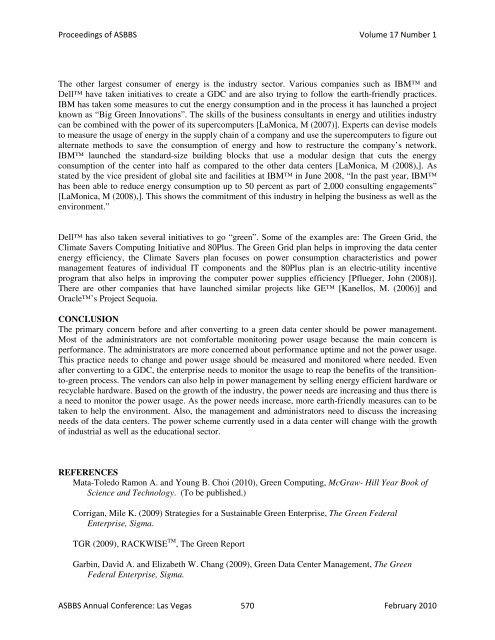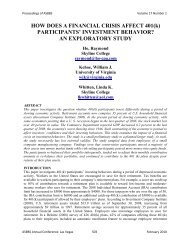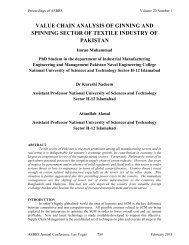GREEN DATA CENTER: HOW GREEN CAN WE ... - Asbbs.org
GREEN DATA CENTER: HOW GREEN CAN WE ... - Asbbs.org
GREEN DATA CENTER: HOW GREEN CAN WE ... - Asbbs.org
Create successful ePaper yourself
Turn your PDF publications into a flip-book with our unique Google optimized e-Paper software.
Proceedings of ASBBS Volume 17 Number 1<br />
The other largest consumer of energy is the industry sector. Various companies such as IBM and<br />
Dell have taken initiatives to create a GDC and are also trying to follow the earth-friendly practices.<br />
IBM has taken some measures to cut the energy consumption and in the process it has launched a project<br />
known as “Big Green Innovations”. The skills of the business consultants in energy and utilities industry<br />
can be combined with the power of its supercomputers [LaMonica, M (2007)]. Experts can devise models<br />
to measure the usage of energy in the supply chain of a company and use the supercomputers to figure out<br />
alternate methods to save the consumption of energy and how to restructure the company’s network.<br />
IBM launched the standard-size building blocks that use a modular design that cuts the energy<br />
consumption of the center into half as compared to the other data centers [LaMonica, M (2008),]. As<br />
stated by the vice president of global site and facilities at IBM in June 2008, “In the past year, IBM<br />
has been able to reduce energy consumption up to 50 percent as part of 2,000 consulting engagements”<br />
[LaMonica, M (2008),]. This shows the commitment of this industry in helping the business as well as the<br />
environment.”<br />
Dell has also taken several initiatives to go “green”. Some of the examples are: The Green Grid, the<br />
Climate Savers Computing Initiative and 80Plus. The Green Grid plan helps in improving the data center<br />
energy efficiency, the Climate Savers plan focuses on power consumption characteristics and power<br />
management features of individual IT components and the 80Plus plan is an electric-utility incentive<br />
program that also helps in improving the computer power supplies efficiency [Pflueger, John (2008)].<br />
There are other companies that have launched similar projects like GE [Kanellos, M. (2006)] and<br />
Oracle’s Project Sequoia.<br />
CONCLUSION<br />
The primary concern before and after converting to a green data center should be power management.<br />
Most of the administrators are not comfortable monitoring power usage because the main concern is<br />
performance. The administrators are more concerned about performance uptime and not the power usage.<br />
This practice needs to change and power usage should be measured and monitored where needed. Even<br />
after converting to a GDC, the enterprise needs to monitor the usage to reap the benefits of the transitionto-green<br />
process. The vendors can also help in power management by selling energy efficient hardware or<br />
recyclable hardware. Based on the growth of the industry, the power needs are increasing and thus there is<br />
a need to monitor the power usage. As the power needs increase, more earth-friendly measures can to be<br />
taken to help the environment. Also, the management and administrators need to discuss the increasing<br />
needs of the data centers. The power scheme currently used in a data center will change with the growth<br />
of industrial as well as the educational sector.<br />
REFERENCES<br />
Mata-Toledo Ramon A. and Young B. Choi (2010), Green Computing, McGraw- Hill Year Book of<br />
Science and Technology. (To be published.)<br />
Corrigan, Mile K. (2009) Strategies for a Sustainable Green Enterprise, The Green Federal<br />
Enterprise, Sigma.<br />
TGR (2009), RACKWISE TM , The Green Report<br />
Garbin, David A. and Elizabeth W. Chang (2009), Green Data Center Management, The Green<br />
Federal Enterprise, Sigma.<br />
ASBBS Annual Conference: Las Vegas 570<br />
February 2010

















